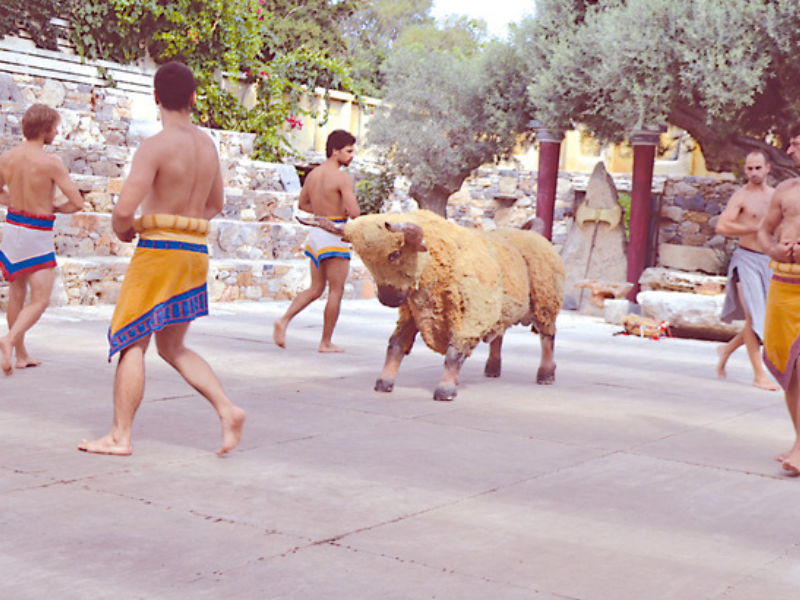Table of Contents
Introduction to Taurokathapsia and Bull-Related Rituals
Throughout history, the bull has played a significant role in various cultural rituals and ceremonies. From the ancient Minoan ritual of Taurokathapsia to modern practices like bullfighting in Spain and rodeo in the United States, these bull-related activities reflect deep-rooted cultural and societal values.
Taurokathapsia in Minoan Culture
Taurokathapsia, the ancient Minoan bull-leaping ritual, was a significant religious and cultural practice in Bronze Age Crete. This ritual, vividly depicted in Minoan frescoes, involved athletes performing acrobatic feats over a charging bull.
The symbolic meanings of Taurokathapsia are subject to various interpretations, ranging from a rite of passage to a symbolic conquest of natural forces. Unlike modern bullfighting, Taurokathapsia was not a combat between human and beast but rather an exhibition of human agility and bravery in harmony with the animal’s power.
Bullfighting in Spain: A Cultural Phenomenon
Bullfighting in Spain, known as corrida de toros, is a tradition with roots possibly dating back to ancient rituals, including Taurokathapsia.
While there is no direct historical lineage connecting Minoan bull-leaping to Spanish bullfighting, some scholars suggest that the Minoan influence on Mediterranean cultures might have indirectly contributed to the evolution of bull-related rituals in later civilizations.
Spanish bullfighting, unlike Taurokathapsia, is a direct combat between the matador and the bull, often resulting in the death of the animal. It is deeply embedded in Spanish culture, symbolizing a dramatic play of life, death, and honor.
Rodeo in the United States: A Modern Take on Bull Interaction
In contrast to the ancient and medieval traditions of the Mediterranean, rodeo in the United States represents a more modern interaction with bulls.
Originating from the cattle-ranching practices of the 19th century, American rodeo includes events like bull riding and steer wrestling. These activities, while competitive and demanding, do not typically involve a battle to the death but rather showcase skills related to cattle handling and cowboy life.

Comparing Rituals: Taurokathapsia, Bullfighting, and Rodeo
The comparison between Taurokathapsia, Spanish bullfighting, and American rodeo reveals fascinating cultural insights.
While Taurokathapsia was a non-lethal display of agility and synchronization with the bull, bullfighting in Spain often culminates in a dramatic, lethal climax, symbolizing a struggle between human and nature. Rodeo, on the other hand, emphasizes human skill in mastering and controlling the bull, reflecting a utilitarian approach aligned with ranching traditions.
Taurokathapsia, with its emphasis on harmony and athleticism, contrasts sharply with the more confrontational nature of bullfighting. However, both share an element of spectacle and are deeply rooted in religious and cultural symbolism. Rodeo, while less ritualistic, still maintains a cultural connection to the animal, celebrating the skills necessary for ranching life.
Cultural and Ethical Perspectives
The cultural symbolism of these bull-related rituals is complex. In Spain, bullfighting is seen by many as an integral part of national identity, though it faces increasing ethical scrutiny. In the United States, rodeo is viewed as a celebration of cowboy culture and heritage. However, it too is subject to ethical debates regarding animal welfare.
Taurokathapsia, as part of Minoan culture, likely had religious significance, possibly related to fertility, strength, and the cycle of life. The modern ethical perspective casts a different light on these ancient practices, inviting us to reconsider the relationship between humans and animals in cultural rituals.
Conclusion
From the ancient Minoan ritual of Taurokathapsia to the modern traditions of bullfighting in Spain and rodeo in the United States, bull-related rituals have long been a part of human culture.
While these practices vary greatly in their execution and underlying meanings, they all reflect the profound impact that the bull has had on human societies across time and space. Understanding these rituals offers not only a glimpse into different cultures but also into the evolving human-animal relationship throughout history.


